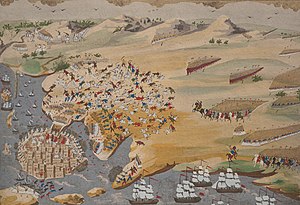Background
After the first unsuccessful attempt to take the town in 1822, another expedition to western Central Greece was undertaken, this time by Mustafa Pasha of Scutari. Mustafa proceeded through the city of Trikala to Karpenisi, where a first Greek attempt to stop his advance resulted in the Battle of Karpenisi. During this battle, the Albanian casualties were 1,000 troops, but the Greeks lost their commander, Markos Botsaris. The second unsuccessful Greek attempt to stop Mustafa at Mount Kaliakouda, on 29 August 1823, resulted in 200 Greek casualties. [2]
Siege
On 17 September the Albanian army was joined by Omer Vrioni and his troops. The two pashas decided to cooperate and siege Missolonghi and Aitoliko, an island which controlled the seaways of the Missolonghi lagoon. [3] The Albanian army arrived before Missolonghi and began the siege on 20 September with a bombardment of Aitoliko. The subsequent attack on Aitoliko failed however. Thousands of cannonballs were fired against the island and only a few of them found their target. [3] [1]
On 17 November, Ottoman food supplies were seized by 250 Souliotes under command of Kitsos Tzavelas. [4] Soon, inside the Albanian camp, clashes between Ghegs and Mirdites occurred due to the lack of food. [3]
Meanwhile rumors arrived that the Ottoman campaign in Eastern Central Greece had failed and damaged the morale of those laying siege. As a result of food shortages and disease, on 20 November Mustafa Pasha lifted the siege, withdrew and retreated to modern-day North Albania. [3] The siege had taken place in early winter, so its premature end was inevitable. [3] [5] [6] [7]
This page is based on this
Wikipedia article Text is available under the
CC BY-SA 4.0 license; additional terms may apply.
Images, videos and audio are available under their respective licenses.


